Companion planting is a gardening technique that involves planting different crops together to enhance their growth and productivity. When it comes to blueberries, companion planting can be especially beneficial. By choosing the right Companion Plants for Blueberries, blueberry growers can improve soil quality, deter pests, and increase yields.
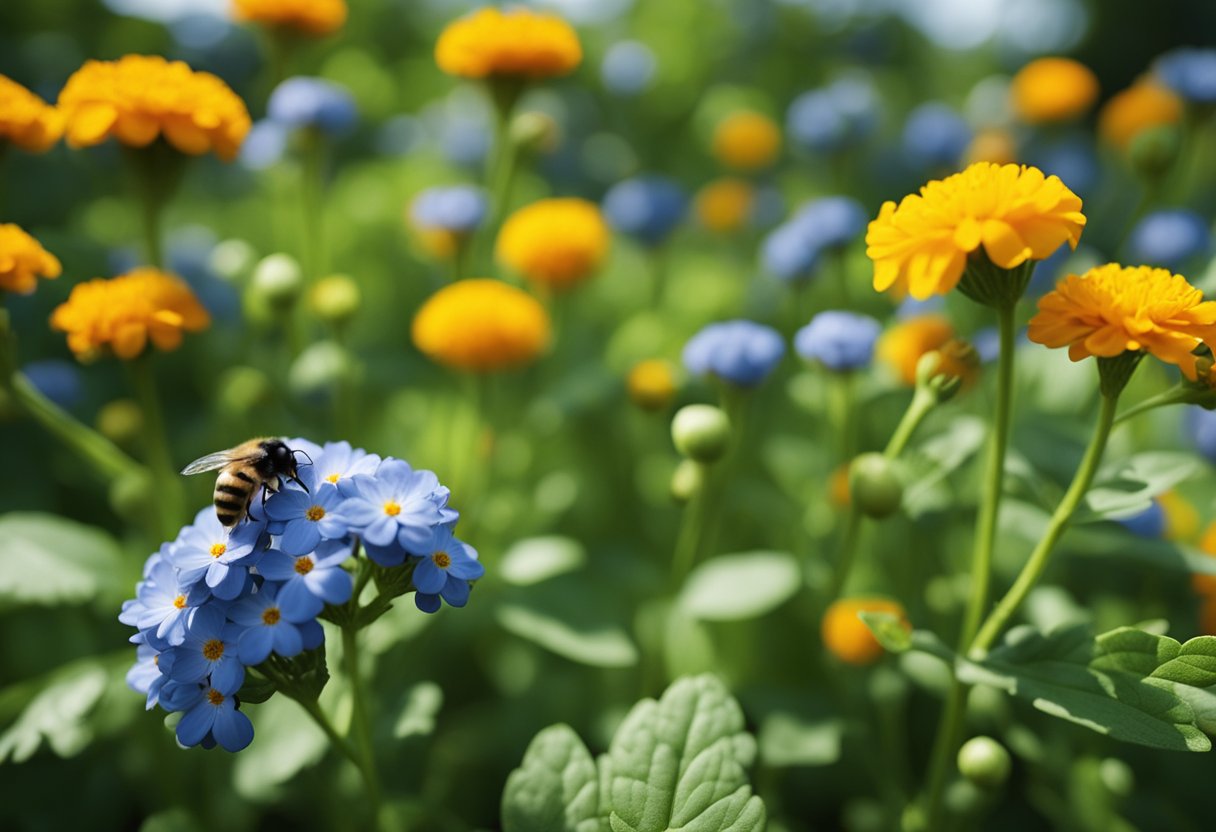
One of the primary benefits of companion planting for blueberries is pest control. Certain plants, such as marigolds and lavender, can help repel pests like aphids and spider mites. In addition, planting herbs like basil and thyme near blueberries can help deter fruit flies and other insects. Companion planting can also help improve soil quality by adding nutrients and organic matter. For example, planting clover or vetch near blueberries can help fix nitrogen in the soil, which is essential for plant growth.
Choosing the right companion plants for blueberries can be a bit tricky, as these plants have specific soil and environmental requirements. However, with a little research and planning, blueberry growers can find the perfect companions to help their plants thrive. In the following sections, I will discuss some of the best companion plants for blueberries, as well as tips for understanding soil conditions, watering and mulching techniques, and more.
Key Takeaways
- Companion planting can enhance the growth and productivity of blueberries by improving soil quality and deterring pests.
- Choosing the right companion plants for blueberries requires careful consideration of soil and environmental conditions.
- Understanding soil conditions, watering and mulching techniques, and spacing and planting strategies are key to successful companion planting with blueberries.
Benefits of Companion Planting
When it comes to growing blueberries, companion planting can offer numerous benefits. Here are a few ways that companion planting can help you grow healthy and productive blueberry plants.
Pest Control
One of the biggest benefits of companion planting is that it can help control pests. Certain plants can attract beneficial insects that prey on pests that can damage blueberry plants. For example, planting marigolds alongside blueberries can help repel harmful nematodes and attract ladybugs, which eat aphids and other pests.
Pollination Enhancement
Blueberries require cross-pollination to produce fruit, and companion planting can help enhance this process. Planting bee-friendly flowers like clover or borage near blueberry bushes can attract pollinators like bees, which can help increase fruit yields.
Soil Health
Companion planting can also help improve soil health. Some plants, like legumes, can fix nitrogen in the soil, which can benefit blueberry plants that require nitrogen-rich soil. Additionally, planting cover crops like clover or buckwheat can help prevent soil erosion and improve soil structure, which can promote healthy root growth in blueberry plants.
Companion planting can be an effective way to promote healthy and productive blueberry plants. By choosing the right companion plants, you can help control pests, enhance pollination, and improve soil health, which can lead to a bountiful harvest of delicious blueberries.
Best Companion Plants for Blueberries
When it comes to growing blueberries, companion planting can be a great way to boost their growth and yield. Here are some of the best companion plants for blueberries.
Herb Companions
Herbs can help improve the flavor and growth of blueberries. Some of the best herb companions for blueberries include:
- Thyme: This herb can help repel pests and improve the flavor of blueberries.
- Sage: Sage can help attract beneficial insects and improve the growth of blueberries.
- Rosemary: Rosemary can help repel pests and improve the flavor of blueberries.
Vegetable Companions
Vegetables can also be great companion plants for blueberries. Some of the best vegetable companions for blueberries include:
- Beans: Beans can help fix nitrogen in the soil, which can benefit blueberries.
- Peppers: Peppers can help repel pests and attract beneficial insects to the blueberry plants.
- Spinach: Spinach can help shade the soil around the blueberry plants and improve their growth.
Flower Companions
Flowers can help attract pollinators and beneficial insects to the blueberry plants. Some of the best flower companions for blueberries include:
- Marigolds: Marigolds can help repel pests and attract beneficial insects to the blueberry plants.
- Lavender: Lavender can help attract pollinators and improve the flavor of blueberries.
- Nasturtiums: Nasturtiums can help repel pests and attract beneficial insects to the blueberry plants.
By planting these companion plants alongside your blueberries, you can help improve their growth, yield, and flavor.
Understanding Soil Conditions
Blueberries are known for their particular soil preferences, which can make it challenging to find suitable companion plants. Understanding the soil conditions that blueberries require, therefore, is crucial in selecting the right companion plants.
Soil pH for Blueberries and Companions
Blueberries require a slightly acidic soil pH of 4.5-5.5 to thrive, which can limit the choice of companion plants. However, some plants can tolerate acidic soil and make excellent companions for blueberries. For instance, azaleas and rhododendrons are acid-loving plants that bloom around the same time as blueberries, attracting pollinators to the garden. Other suitable companion plants for blueberries include:
- Alliums, which repel pests and improve soil fertility
- Ferns, which provide shade and moisture retention
- Lupines, which fix nitrogen in the soil
- Lingonberries, which have similar soil and sun requirements as blueberries
Soil Type Preferences
In addition to pH, blueberries also prefer well-draining, light, and fertile soil with plenty of organic matter. Sandy loam soil is ideal for blueberries as it provides good drainage and aeration, which helps prevent root rot. However, clay soil can be problematic as it retains too much moisture and can cause root suffocation.
When selecting companion plants for blueberries, it’s essential to consider their soil type preferences. For instance, ferns prefer moist soil, while lupines and lingonberries prefer well-draining soil. Therefore, it’s crucial to choose companion plants that have similar soil requirements to blueberries to ensure they thrive together.
Understanding the soil conditions that blueberries require is crucial in selecting suitable companion plants. By choosing plants that have similar soil pH and type preferences, you can create a thriving garden that benefits both the blueberries and their companions.
Watering and Mulching Techniques
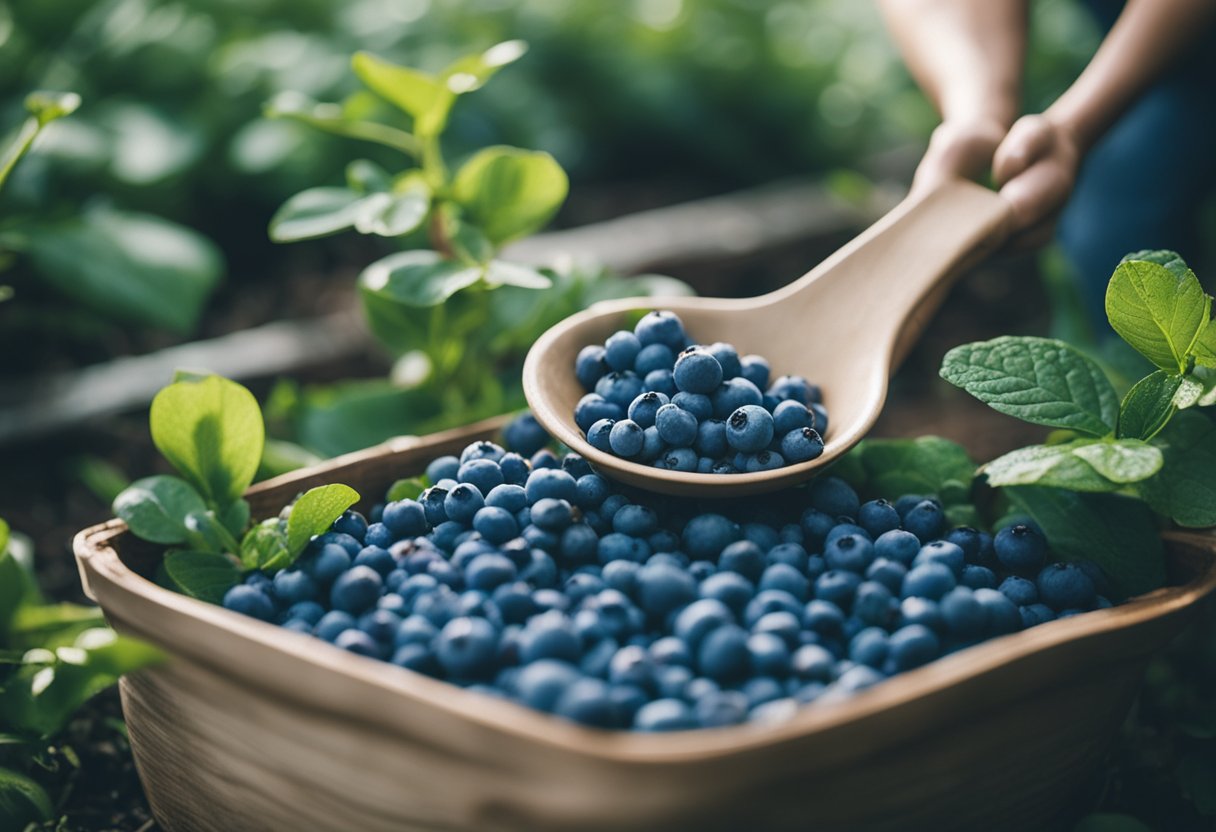
Irrigation Practices
As a blueberry plant owner, it is essential to water your plants regularly and consistently. Blueberries require a lot of water, especially during their growing season. However, overwatering can cause root rot, so it is important to avoid excessive watering.
To ensure that your blueberry plants are getting the right amount of water, it is recommended to use a drip irrigation system. This system delivers water directly to the roots, which reduces the risk of overwatering.
Another important irrigation practice is to water your blueberry plants in the morning. Watering in the morning allows the plants to absorb the water before the heat of the day causes it to evaporate. This practice also reduces the risk of fungal diseases, which can thrive in moist conditions.
Mulching Materials
Mulching is another essential practice for blueberry plant owners. Mulch helps to retain moisture in the soil and regulate soil temperature. It also suppresses weed growth, which can compete with blueberry plants for nutrients and water.
When choosing a mulching material, it is important to consider the pH level of the soil. Blueberries require acidic soil, so it is recommended to use acidic mulches such as pine needles, sawdust, or wood chips.
In addition to being acidic, the mulch should be organic and free from weed seeds. Organic mulches such as straw or leaves are great options as they break down over time and add nutrients to the soil.
Proper irrigation and mulching practices are crucial for the health and growth of blueberry plants. By using a drip irrigation system and choosing the right mulching material, you can ensure that your blueberry plants thrive and produce delicious berries.
Spacing and Planting Strategies
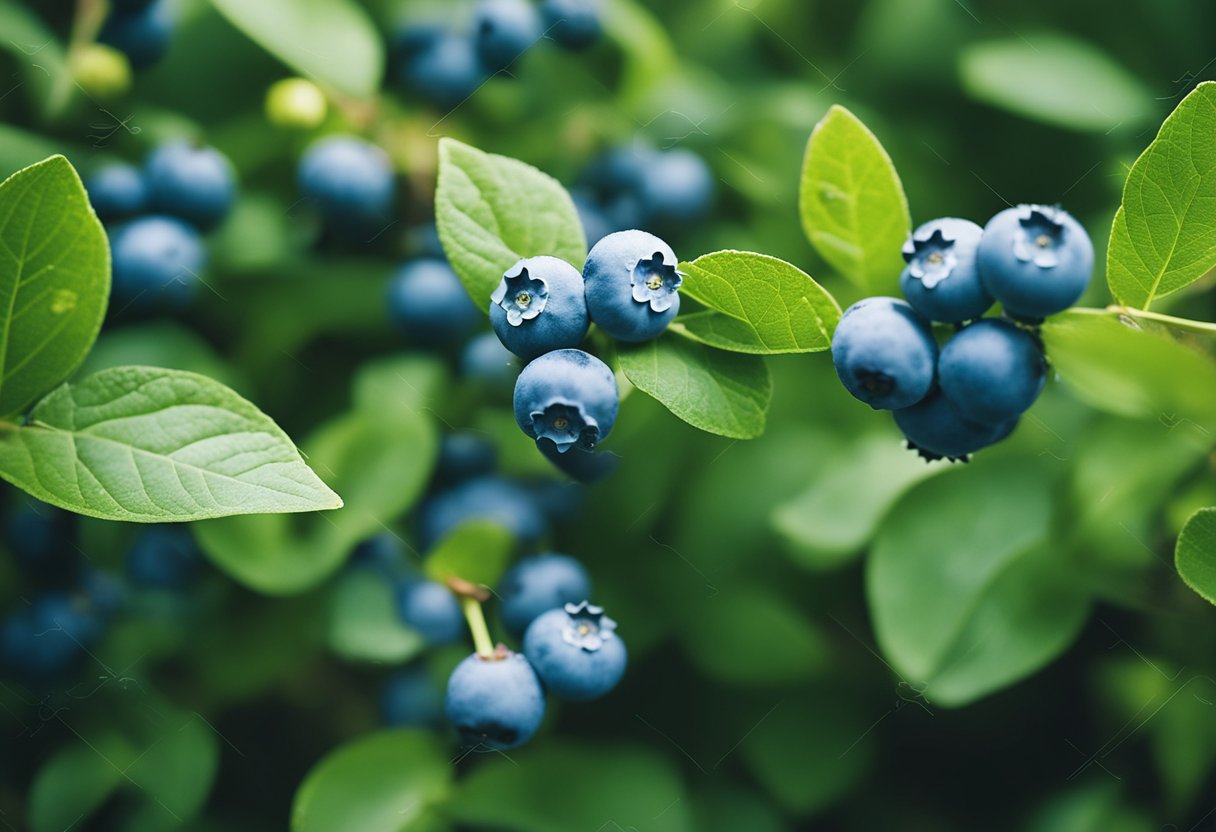
When it comes to companion planting for blueberries, spacing and planting strategies are crucial to ensure optimal growth and productivity. In this section, I will discuss two main strategies for planting blueberries with companion plants: row planting and intercropping.
Row Planting
Row planting is a common strategy used by many blueberry growers. This involves planting blueberry bushes in rows with companion plants in between. The spacing between the rows should be at least 8 feet to allow for ample sunlight and air circulation. The distance between the blueberry bushes within a row should be around 4 to 6 feet.
Companion plants that work well with blueberries in row planting include clover, which is a nitrogen-fixing plant that can improve soil fertility, and strawberries, which have similar growing conditions to blueberries and can help control weeds.
Intercropping
Intercropping involves planting companion plants within the same row as the blueberry bushes. This strategy can help maximize space and increase productivity. However, it requires careful planning to ensure that the companion plants do not compete with the blueberry bushes for resources such as water and nutrients.
Companion plants that work well with blueberries in intercropping include herbs like basil and thyme, which can help repel pests and attract beneficial insects, and flowers like marigolds and nasturtiums, which can help control weeds and provide additional color and beauty to the garden.
Choosing the right spacing and planting strategy is essential for successful companion planting with blueberries. By following these tips, you can create a thriving garden that not only produces delicious blueberries but also benefits from the natural synergy of companion planting.
Seasonal Care and Maintenance
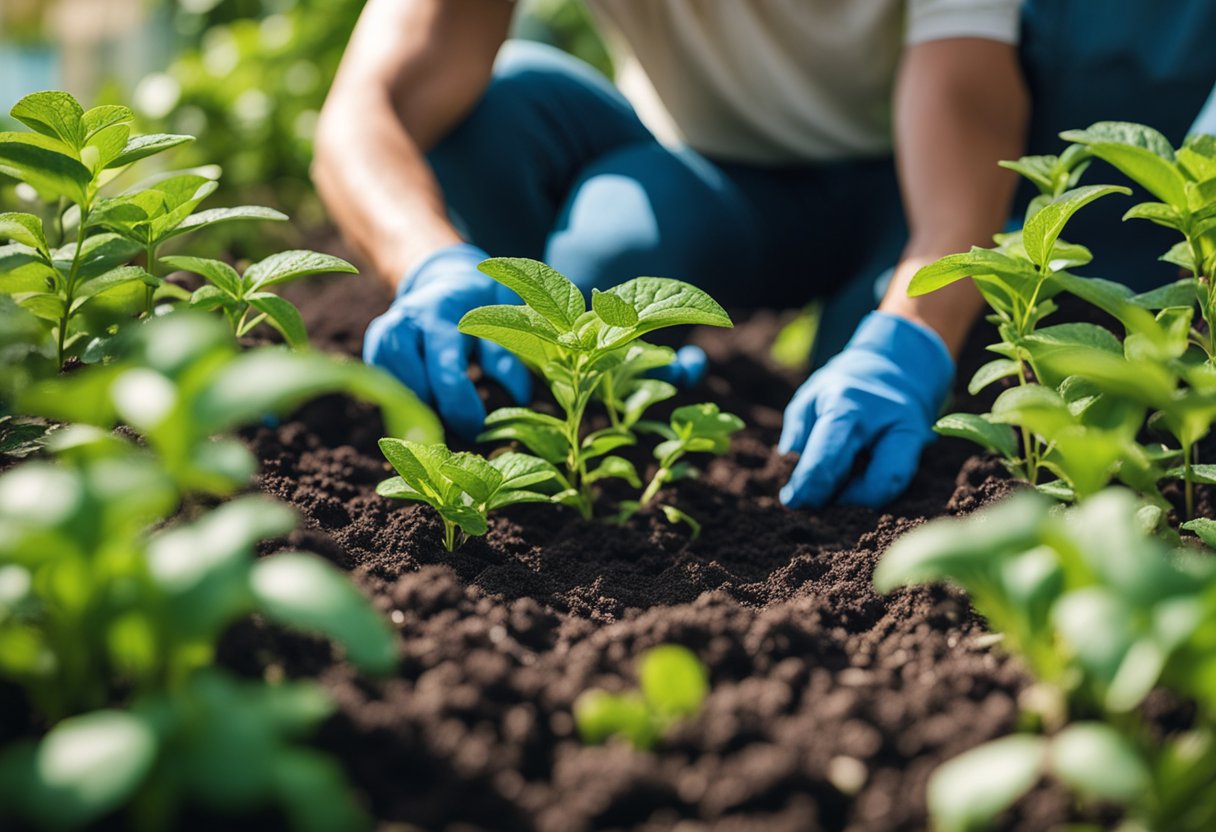
Spring Preparation
As the weather warms up and the blueberry bushes begin to bud, it’s important to take some steps to prepare for the upcoming growing season. Here are some tasks I like to do in the spring:
- Prune: I carefully prune any dead or diseased branches from the blueberry bushes. I also remove any low-hanging branches that could touch the ground and potentially transfer diseases or pests to the bushes.
- Fertilize: Blueberries love acidic soil, so I like to fertilize with an acid-loving fertilizer in the spring. I also add a layer of organic mulch around the base of the bushes to help retain moisture and suppress weeds.
- Check for pests: I keep an eye out for any signs of pests, such as aphids or mites, and treat them promptly if I see them. One natural solution is to spray the bushes with a mixture of water and neem oil.
Fall Cleanup
As the growing season comes to an end and the leaves begin to turn, it’s time to start thinking about preparing the blueberry bushes for winter. Here are some tasks I like to do in the fall:
- Harvest: I pick all the ripe blueberries, making sure to remove any overripe or moldy berries. I also remove any fallen berries from the ground to prevent pests from overwintering.
- Prune: In the fall, I prune any branches that are crossing or rubbing against each other. I also remove any weak or spindly growth to encourage stronger growth next year.
- Mulch: I add another layer of organic mulch around the base of the bushes to help protect the roots from freezing temperatures. I also cover the bushes with burlap to protect them from harsh winter winds.
By following these seasonal care and maintenance tasks, you can help ensure that your blueberry bushes stay healthy and productive year after year.
Common Challenges in Companion Planting
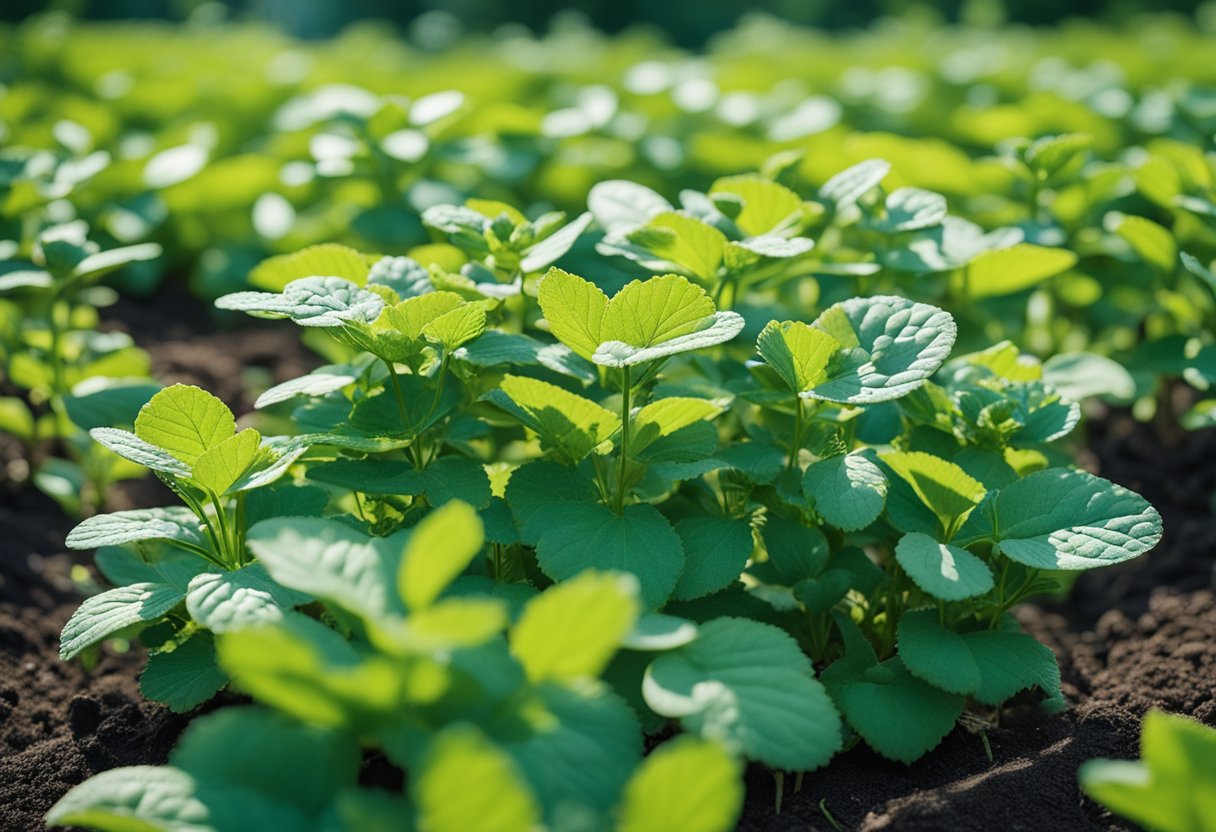
Incompatible Plants
When choosing companion plants for blueberries, it is important to consider plants that are compatible with blueberries. Some plants may negatively affect the growth and yield of blueberries. For example, plants that prefer alkaline soil may not be suitable for growing near blueberries, which require acidic soil. Incompatible plants may compete for nutrients, water, and sunlight, leading to stunted growth and reduced yield.
To avoid incompatible plants, it is important to research the specific needs of each potential companion plant before planting them near blueberries. Some plants that are commonly considered to be incompatible with blueberries include potatoes, tomatoes, and peppers.
Disease Management
Another challenge in companion planting is disease management. Companion plants can help prevent pests and diseases from attacking blueberries, but they can also harbor pests and diseases that may affect blueberries. For example, plants in the nightshade family, such as tomatoes and peppers, can attract the same pests that attack blueberries, such as flea beetles and aphids.
To manage disease in companion planting, it is important to choose plants that are resistant to common pests and diseases, and to rotate crops regularly to prevent the buildup of pests and diseases in the soil. Additionally, it is important to monitor plants regularly for signs of pests and diseases and to take action promptly to prevent the spread of infection.
While companion planting can be a useful technique for growing healthy blueberry plants, it is important to be aware of potential challenges and to take steps to manage them effectively. By choosing compatible plants and practicing good disease management, it is possible to create a thriving blueberry garden with the help of companion plants.
Harvesting and Yield Optimization
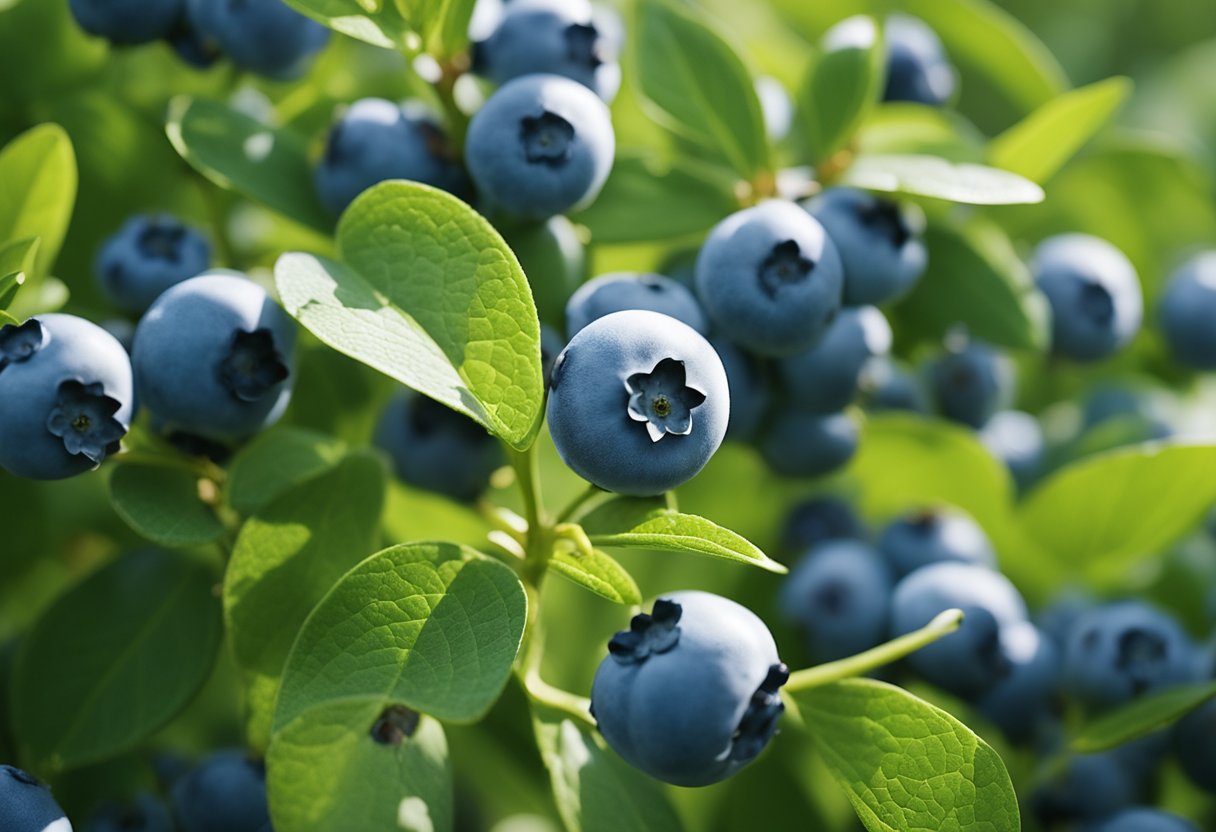
As a blueberry grower, I’m always looking for ways to optimize my harvest and yield. Here are some tips to help you get the most out of your blueberry plants.
Timing Harvest
Timing the harvest of your blueberries is crucial to ensure that you get the best quality fruit. Blueberries are usually ready to harvest in late spring or early summer, depending on the variety. The fruit should be firm, plump, and have a blue-gray color. If the fruit is still red, it is not ripe yet.
It’s important to harvest blueberries at the right time to avoid over-ripening or under-ripening. Over-ripened fruit can be soft and mushy, while under-ripened fruit can be sour and not very flavorful.
Maximizing Yield
To maximize your blueberry yield, you can use companion planting techniques. Companion plants are plants that grow well with blueberries and can help to improve soil fertility, attract pollinators, and repel pests.
Some of the best companion plants for blueberries include clover, strawberries, and thyme. Clover is a nitrogen-fixing plant that can help to improve soil fertility, while strawberries and thyme can attract pollinators such as bees and butterflies.
In addition to companion planting, you can also prune your blueberry bushes to promote better fruit growth and yield. Pruning can help to remove dead or diseased wood, improve air circulation, and encourage new growth.
By following these tips, you can optimize your blueberry harvest and yield, and enjoy delicious, healthy fruit all season long.
Related Post: White Flowers With Black Center
Environmental Impact and Sustainability
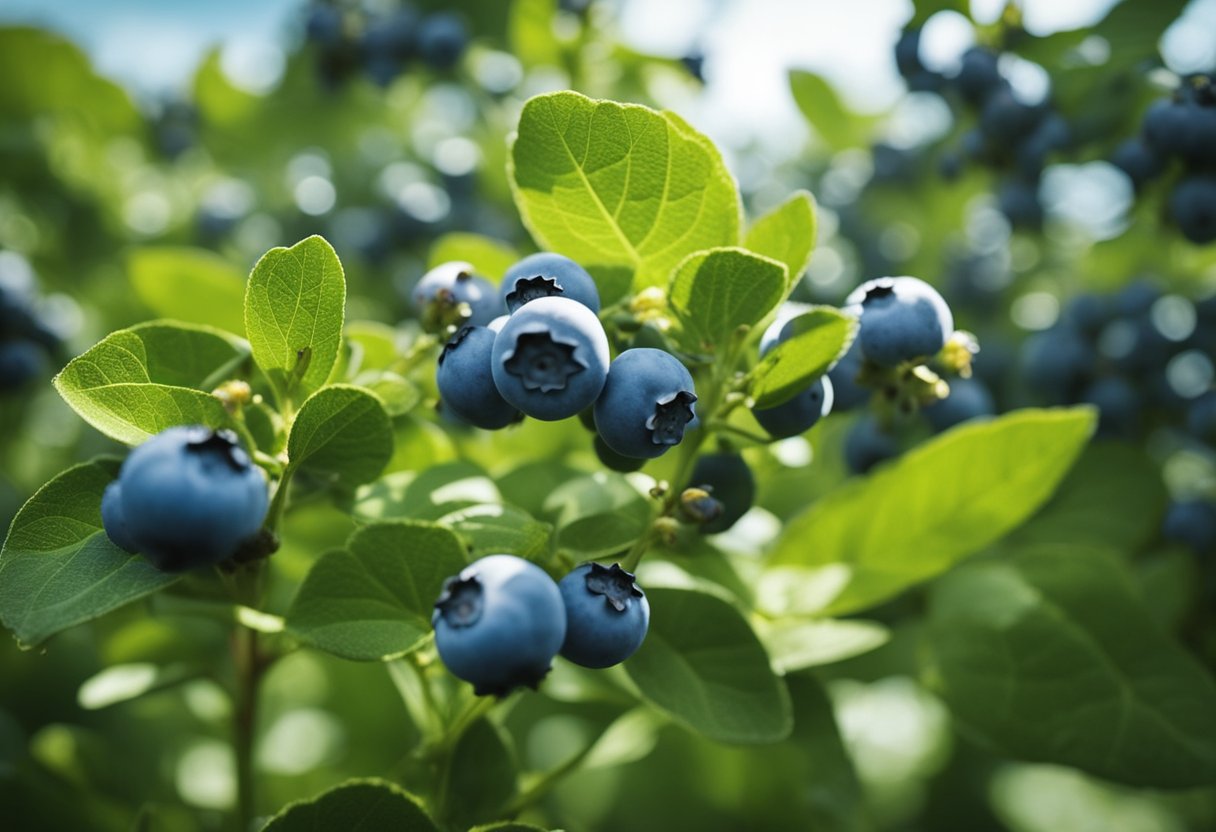
Blueberries are a popular fruit crop in many parts of the world, and they can be grown sustainably with the help of companion plants. In this section, I will discuss the environmental impact of blueberry cultivation and how companion planting can help promote sustainability.
Wildlife Habitats
Blueberries are known to attract a variety of wildlife, including birds, bees, and butterflies. By planting companion plants that provide food and shelter for these creatures, blueberry growers can create a more diverse and vibrant ecosystem. Some of the best companion plants for blueberries include clover, lupines, and bee balm, all of which attract pollinators and other beneficial insects.
Resource Conservation
Blueberry cultivation can be resource-intensive, requiring large amounts of water, fertilizer, and pesticides. However, by using companion plants that help conserve resources, growers can reduce their environmental impact. For example, planting nitrogen-fixing plants like clover and vetch can help reduce the need for fertilizer, while intercropping with legumes like beans and peas can help reduce water use.
Companion planting is an effective way to promote sustainability in blueberry cultivation. By creating a more diverse and resilient ecosystem, blueberry growers can reduce their environmental impact while also improving the health and productivity of their crops.
Frequently Asked Questions
What are the best flowers to plant alongside blueberry bushes?
There are several flower species that can be planted alongside blueberry bushes, including azaleas, heather, gardenias, and mountain laurel. These flowers can attract pollinators and help to keep pests away from the blueberry bushes.
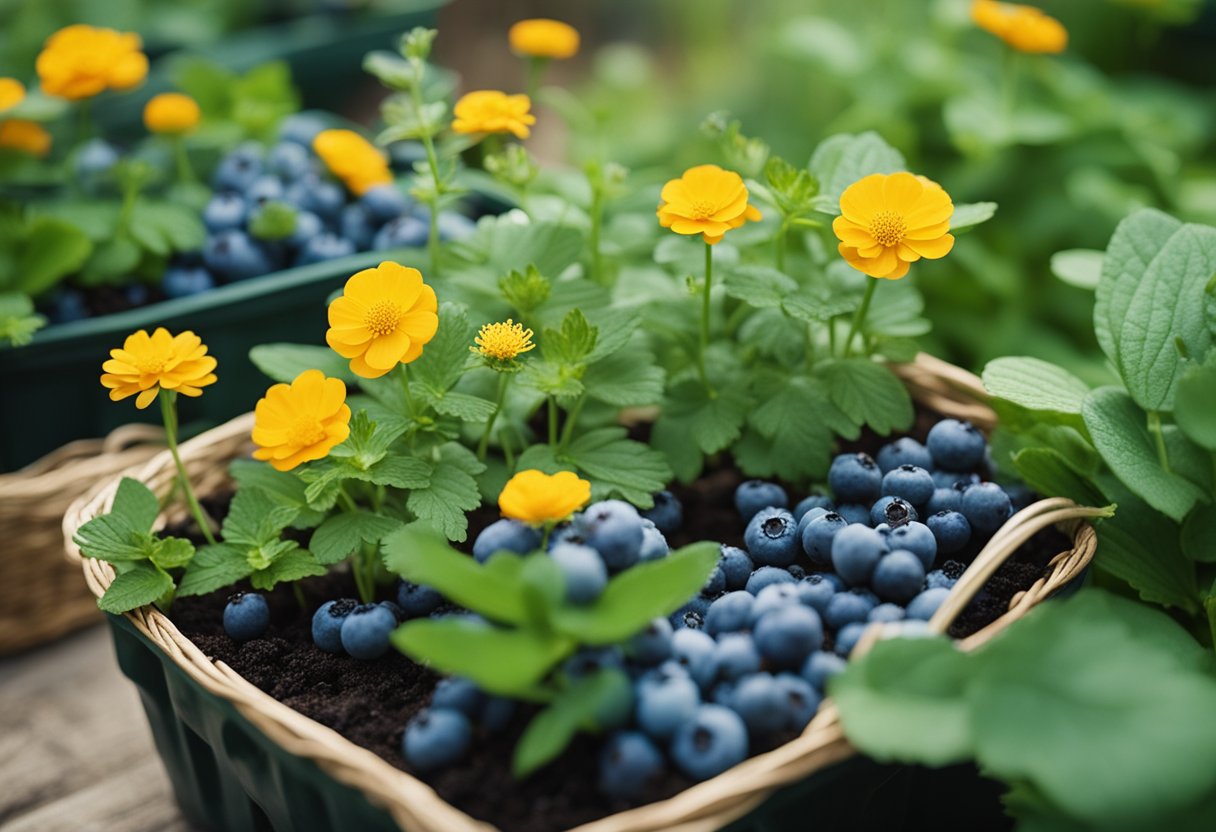
Which herbs can be grown as companion plants to blueberries?
Some herbs that can be grown as companion plants to blueberries include basil, thyme, and comfrey. These herbs can tolerate acidic soil and can help to repel pests from the blueberry bushes.
Are there any plants that should not be placed near blueberry bushes?
Yes, there are some plants that should not be placed near blueberry bushes. These include junipers, lilacs, and rhododendrons. These plants prefer alkaline soil, which is not ideal for blueberry bushes.
Can strawberries and blueberries be planted together effectively?
Yes, strawberries and blueberries can be planted together effectively. In fact, strawberries can be a great companion plant for blueberries, as they can help to attract pollinators and can also help to keep pests away from the blueberry bushes.
How does planting marigolds affect blueberry plants?
Planting marigolds alongside blueberry bushes can be beneficial, as marigolds can help to repel pests and can also attract beneficial insects to the area. However, it is important to note that marigolds prefer well-draining soil, so they should not be planted in areas with heavy clay soil.
Is it beneficial to grow rhubarb in proximity to blueberry bushes?
Yes, it can be beneficial to grow rhubarb in proximity to blueberry bushes. Rhubarb can help to improve soil quality and can also attract beneficial insects to the area. However, it is important to note that rhubarb should be planted in well-draining soil and should not be over-watered.